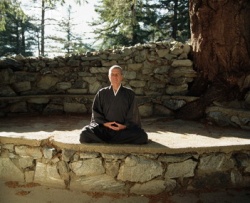Difference between revisions of "Satori"
| Line 42: | Line 42: | ||
| − | [[Wumen]] himself struggled for six years with [[koan]] "[[Zhaozhou’s dog]]", assigned to him by [[Yuelin Shiguan]] ([[月林師觀]]; {{Wiki|Japanese}}: [[Gatsurin | + | [[Wumen]] himself struggled for six years with [[koan]] "[[Zhaozhou’s dog]]", assigned to him by [[Yuelin Shiguan]] ([[月林師觀]]; {{Wiki|Japanese}}: [[Gatsurin Shikan]]) (1143–1217), before [[attaining]] [[kenshō]]. After his [[understanding]] had been confirmed by [[Yuelin]], [[Wumen]] wrote the following [[enlightenment]] poem: |
<poem> | <poem> | ||
A thunderclap under the clear blue sky | A thunderclap under the clear blue sky | ||
Revision as of 10:53, 10 January 2015
Satori (悟り) (Chinese: 悟; pinyin: wù; Korean: 오 o; Vietnamese: ngộ) is a Japanese Buddhist term for awakening, "comprehension; understanding". It is derived from the verb satoru.
In the Zen Buddhist tradition, satori refers to the experience of kenshō, "nature". Ken means "seeing," shō means "nature" or "essence."
Satori and kenshō are commonly translated as enlightenment, a word that is also used to translate bodhi, prajna and buddhahood.
Definitions
- D.T. Suzuki: "Looking into one's nature or the opening of satori"; "This acquiring of a new point of view in our dealings with life and the world is popularly called by Japanese Zen students 'satori' (wu in Chinese). It is really another name for Enlightenment ("Annuttara-samyak-sambodhi")".
Satori and kenshō
Satori is often used interchangeably with kenshō. Kenshō refers to the perception of the Buddha-Nature or emptiness. According to some authors, kenshō is a brief glimpse, while satori is considered to be a deeper spiritual experience.
Distinct from this first insight, daigo-tettei is used to refer to a "deep" or lasting realization of the nature of existence.
Importance of satori
According to D. T. Suzuki,
- Satori is the raison d'être of Zen, without which Zen is no Zen. Therefore every contrivance, disciplinary and doctrinal, is directed towards satori.
This view is typical of Rinzai, which emphasizes satori. The Soto school rejects this emphasis, and instead emphasizes "silent illumination" through the practice of zazen.
Attaining satori
Satori is considered a "first step" or embarkation toward nirvana:
- Ch'an expressions refer to enlightenment as "[[seeing] your self-nature]]". But even this is not enough. After seeing your self-nature, you need to deepen your experience even further and bring it into maturation. You should have enlightenment experience again and again and support them with continuous practice. Even though Ch'an says that at the time of enlightenment, your outlook is the same as of the Buddha, you are not yet a full Buddha.
The student's mind must be prepared by rigorous study, with the use of koans, and the practice of meditation to concentrate the mind, under the guidance of a teacher. Koans are short anecdotes of verbal exchanges between teachers and students, typically of the Song dynasty, dealing with Buddhist teachings. The Rinzai-school utilizes classic collections of koans such as the Gateless Gate. The Gateless Gate was assembled by the early 13th century Chinese Zen master Wumen Hui-k'ai (無門慧開).
Wumen himself struggled for six years with koan "Zhaozhou’s dog", assigned to him by Yuelin Shiguan (月林師觀; Japanese: Gatsurin Shikan) (1143–1217), before attaining kenshō. After his understanding had been confirmed by Yuelin, Wumen wrote the following enlightenment poem:
A thunderclap under the clear blue sky
All beings on earth open their eyes;
Everything under heaven bows together;
Mount Sumeru leaps up and dances.

